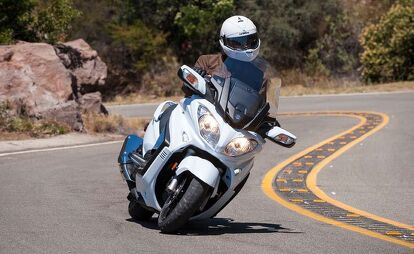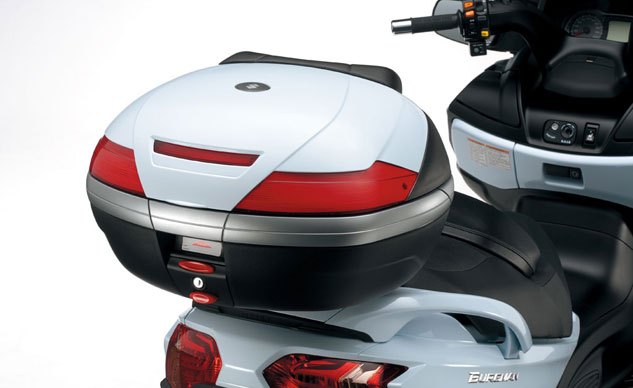2013 Suzuki Burgman 650 ABS Review
All Hail the Mighty Burg
“Wow.” I caught myself uttering that exclamation numerous times over the last few days. Bemused or befuddled, the 2013 Suzuki Burgman 650 ABS sure left me gaping.
I first said “wow” long and low when I initially twisted the scooter’s throttle, pleasantly surprised at the smoothness and depth of its powerband. Shortly thereafter, I said it again matter-of-factly when I looked for a cruise control button that didn’t exist. I hooted it under my helmet while leaning hard into an uphill corner, enthralled by the bike’s surprising dexterity; I muttered it in disbelief after fully raising the electric windshield and discovering it didn’t even reach eye level. I said it aloud, impressed, when I used my bare hand to adjust the rear shocks’ preload; I said it aloud again, perplexed, when I saw I’d burned half a tank of fuel in just 73 miles. Finally, I mouthed it incredulously thanks to a serious case of sticker shock.
That one word expressed a ton of emotions about the Burgman 650 ABS. I ultimately walked away from the step-through more impressed than depressed; it’s no wonder it’s the segment leader with a legion of devotees. With comfort, power and agility, after a 300-mile test ride the new Burgman proved itself both a fun tripper and a capable commuting workhorse. But it’s not without its issues.
The renowned maxi-scooter celebrates its 10th birthday in 2013, and while it didn’t get a tip-to-tail reinvention, the new Burgman receives a stylistic makeover and several engineering upgrades – the motorcycle equivalent of a spa day. Does it go far enough to attract a new audience?
For starters, Suzuki turned to the Burgman’s loyal fan base (Burgman riding club and group members number in the tens of thousands worldwide) and asked them: If you could change anything about the Burgman, what would it be? Unsurprisingly, these devotees didn’t find much fault with the big step-through, but a few key suggestions kept recurring.
First and foremost, ABS, a feature previously available only the on the Burgman Executive, is now standard. (The “Executive” designation has been respectfully resigned; the other features that previously set the Executive apart from the standard Burgman, heated seats and handgrips, are now optional in North America, and standard equipment in the rest of the world.) Not that this was a common complaint, but in 2013 it’s a safety feature no street-bound motorcycle should be without. The ABS is accentuated by the addition of floating discs up front.
This year’s Burg also gets a stylistic upgrade, with a slimmer seat, a sportier nose and headlight arrangement, new taillights more suited to a motorcycle than a car, black accented bodywork, a floorboard cutout for easier foot-planting and an upswept, triangular muffler to replace the tired round one.
Instrumentation, previously dominated by a large, outmoded LED speedometer, has been given a modern makeover, featuring a nouveau-retro analog speedo and tachometer bookending a multi-function LED screen that displays an odometer, twin trip meters, a fuel consumption meter, a coolant temperature indicator, thermometer, clock, programmable oil change indicator, a drive mode indicator (for drive mode and power mode), and a gear-position indicator (for manual mode).
Other refinements of note: the dash now features a green-lit Eco-Drive indicator light; the parking brake lever was relocated from under the right side of the dash to just below the rider’s left thigh for easier accessibility; and the 12-volt accessory plug in the locking dash compartment was moved deeper into the cubby, allowing multiple types and sizes of jacks and accessories to plug in without blocking the hatch.
Finally and perhaps most importantly, new materials were utilized in the clutch and transmission. The result is a much more dexterous Burgman. The new version has substantially less drag and is therefore significantly easier to push around while idling or powered off. This was by far the most common complaint Suzuki heard from current Burgman owners, who are often older riders who just can’t throw a leg over a seat anymore, and Suzuki responded with the new materials that provide a whopping 35% less drag in the drivetrain.
While I never had the opportunity to ride the older Burgmans, I found the 2013 version a breeze to push, whether seated upon it or walking alongside it. Moreover, several moto-journalists along for the press ride remarked how much nimbler the ’13 Burgman felt than its predecessor.
On the road, the Burgman didn’t disappoint in the slightest. Its power is impressive; the DOHC, 638cc twin-cylinder engine picks up immediately and pushes the bike into traffic and onto freeway onramps with aplomb, and it reaches a cruising speed as quickly as most any motorcycle in the same range. There’s ample power at the top end. Accelerating from 60 to 80 takes seconds, and there’s plenty of throttle left beyond that; a top speed of better than 110 mph isn’t inconceivable. Although its redline is set at 8K, around town or cruising the highway the Burg prefers a sweet spot around 4,750 rpm.
The CVT transmission delivers six gear ratios, atypical to most CVTs. Drive mode is the default, but clicking the Power button with your left thumb moves up the shift points, making for quicker acceleration and more amenable low-speed maneuverability. This was handy not only on the street but on the California highways, where lane-splitting is not illegal and sudden adjustments are a must. (Also handy while lane-splitting were the electrically retractable rear-view mirrors operated by a blue button on top of the left switchgear.) I stayed in Power mode for much of the ride, opting for Drive only on the interstate when 6th gear was all that was required to move the scooter along at a 75-mph clip.
For more adjustability, the CVT can be mostly disabled by switching to Manual on the left switchgear, allowing the rider to shift up and down as desired. I say “mostly” because even in Manual mode the Burgman automatically downshifts when slowing to a stop.
My only gripe with Manual mode was that the Up and Down buttons are both facing the rider on the switchgear, meaning they can only be actuated with the thumb. I would prefer a thumb-and-forefinger paddle shifter as on the Honda CTX700 or Can-Am Spyder, but since downshifting is not required in Manual mode, that point may be moot.
In the twisties, the Burgman displays surprising agility – and not just in Manual trans-mode. As long as Power mode is engaged, this maxi-scoot is a sprightly hill-climber. The hardest part is staying in your seat, as the ride is somewhat squishy. But, as previously mentioned, the dual rear shocks are tool-lessly preload adjustable, and two easy clicks on either side firm up the suspension nicely. And the cornering clearance is impressive – it takes a lot of effort to scrape the (standard) centerstand.
But shredding is decidedly not the purpose for which this machine is intended. It’s a commuter through and through, and for that purpose the Burgman is (almost) ideally suited. The underseat storage claims to fit two full-face helmets, and is certainly roomy enough to fit a briefcase, a backpack, even an overnight bag. It’s comfortable, has plenty of giddy-up, and is spry yet stout enough to negotiate the urban jungle. And it provides stress-free, twist-and-go operation.
So what keeps the Burgman from commuting perfection? For one thing, we’d hope for a cruise control function for a highway-ready “luxury scooter,” but when questioned Suzuki admitted that a reasonably inexpensive CC module such as the ones prevalent on so many modern motorcycles would require a ride-by-wire throttle, a tech feature the Burgman cannot (yet) boast. Fair enough.
Another foible, if wind protection is a priority, is the Burgman’s adjustable windshield. The screen itself is fine; it stays well below the rider’s line of sight and provides decent protection from elements while letting cooling air hit the pilot square in the face. But, dialed up to its highest level, the screen doesn’t angle upward to provide a functional air pocket, so it might not be enough to satisfy a fussy passenger or a rain rider. Its leading edge comes a few inches toward the rider’s face — then stops, still well below eye level. In a downpour, any moisture captured by the screen would likely creep up the shield and fly directly into the pilot’s face.
Finally, Suzuki claims the 35% less drag in the transmission improves the Burgman 650’s fuel consumption by 15% (in Drive mode). That’s a nice talking point in and of itself — but after 300 miles, more than half of it on the freeway, we expected higher than 41 mpg. Heck, my wife’s Prius makes better than that. Despite the reduced drag, one would be fortunate to achieve 175 miles on a tank.
None of these issues would be deal-breakers on most scooters, but the Burgman is – as Suzuki will tell you – more bike than most scooters. And while the Burgman is as tight a package as you’ll find in the segment, it’s also the costliest.
At $10,999, the mighty Burg runs a full thousand dollars more than BMW’s comparable C 650 GT, $1,700 more than Honda’s slightly smaller Silver Wing ABS, and – get this – $3K more than Honda’s new no-shift CTX700 motorcycle. That price point, in fact, sits higher than any other scooter we could find, and is greater than the MSRP of many motorcycles. (Shoot, for eleven grand, I might even sell you the wife’s Prius.)
For that kind of price disparity it’s not unreasonable to expect opulence that floors the competition. How about an audio system with iPod connectivity? Perhaps the aforementioned cruise control? Navigation? Any or all of the above? Sorry, no. For an extra grand (at least), what you get is an easy to ride, highway-ready maxi-scooter with plenty of cargo space and a solid powertrain.
So maybe it is time for that tip-to-tail reinvention. Because despite the nice array of upgrades, the 2013 Suzuki Burgman 650 ABS still has room for improvement. It may be the king of its segment and have legions of devoted fans, but anyone with a desire to jump on the maxi-scooter bandwagon won’t need to look far to find more economically attractive options.
+ Highs
- Surprising power and agility
- Capacious cargo space
- Far easier to push around than its predecessors
– Sighs
- More expensive than many motorcycles
- Mediocre fuel economy
- Frustrating windscreen
What’s In A Name?
My curiosity finally got the nest of me, so I asked Derek Schoeberle, Suzuki’s Media Relations Manager, a pointed question.
“Who the heck is Burgman and why did he get a Suzuki scooter named after him?”
Schoeberle smiled and shook his head. “Well, Jon,” he said with a sigh, “think of a ‘burg’ as a town or city, right? Like Pittsburgh or Williamsburg? So a ‘burg man’ is someone who lives in a town or city. That’s why the name is ideal for this scooter, because this scooter is ideal for someone who lives in a city – a ‘burg man.’”
Oh.
More by Jon Langston















































Comments
Join the conversation
Yeah, the stock windshield is a piece of shit, i have a Clearview on mine which is light years better and I too was surprised and disappointed they didn't add cruise control on the new Burgman. Next time Suzuki, cruise control and fix the damn windshield, for 11 grand, they should both be standard.
I'm waiting for a Burgman 650 with stereo!